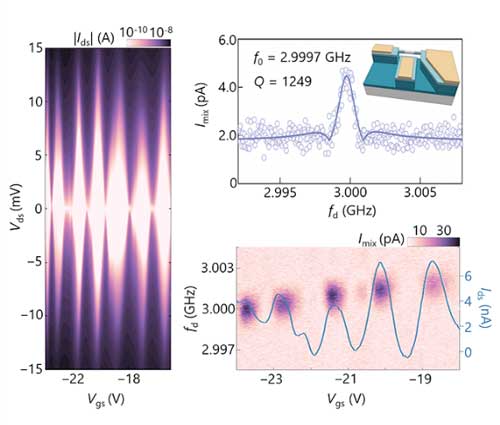| Dec 15, 2020 |
Researchers develop Si-based super-high frequency nanoelectromechanical resonator
(Nanowerk News) Silicon single-electron/hole transistors (SETs/SHTs) and super-high frequency nanoelectromechanical resonators show great potentials in quantum computation, sensing and many other areas.
|
|
Recently, a group led by Prof. GUO Guoping from the University of Science and Technology of China of the Chinese Academy of Sciences, collaborating with Prof. ZHANG Zhen's group from Uppsala University, Sweden, designed and fabricated CMOS-compatible suspended SHT devices which worked as super-high frequency nanoelectromechanical resonators.
|
|
The work was published in Advanced Materials ("A Suspended Silicon Single-Hole Transistor as an Extremely Scaled Gigahertz Nanoelectromechanical Beam Resonator").
|
 |
| Characterization of the electrical and mechanical properties of the hybrid device. (Image: ZHANG Zhuozhi et.al.)
|
|
Specifically, if the SHT is suspended, it can also work as a super-high frequency nanoelectromechanical resonator. Such hybrid architecture can demonstrate not only single-hole tunneling behavior, but also excellent mechanical properties.
|
|
These properties will be helpful for exploring the interactions between mechanical vibrations and charge carriers, and investigating potential quantum effects.
|
|
Meanwhile, such hybrid device can be applied to study the piezoresistive effect of silicon in nanoscale, which is beneficial for designing novel mechanical sensing devices.
|
|
At ultra-low temperature and under high vacuum, the device showed single-hole tunneling behavior and a mechanical resonance at a record high value of 3 GHz. Meanwhile, researchers also found that the electrical readout of the mechanical resonance mainly relied on piezoresistive effect, and was strongly correlated to single-hole tunneling.
|
|
Comparing the device response at different driving powers, they found that in the SHT regime, the piezoresistive gauge factor was an order of magnitude larger.
|
|
The hybrid device was fabricated using CMOS technology, which is convenient for large-scale integration. This work provides new opportunities for investigating coupling between vibrational phonon modes in nanoelectromechanical resonators with charge carriers in silicon quantum dots.
|
|
At ultra-low temperature, the corresponding thermal phonon occupation and zero-point motion of the mechanical resonance have both exceeded the quantum limits.
|
|
The results also shed lights on studying potential quantum behavior of super-high frequency vibrational phonon modes and development of phonon-based novel quantum devices.
|

